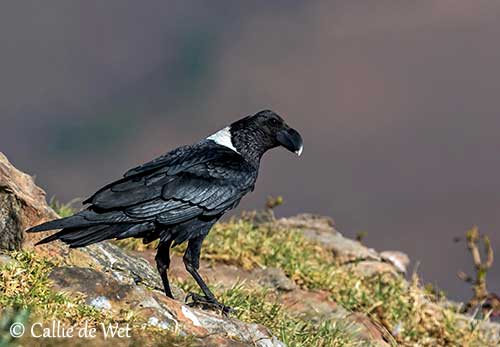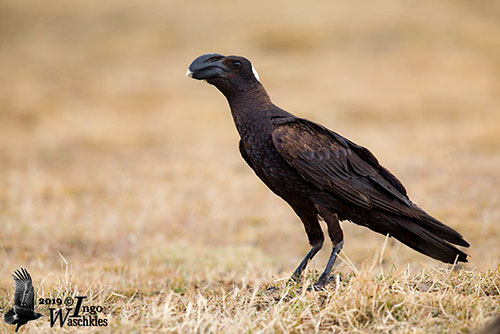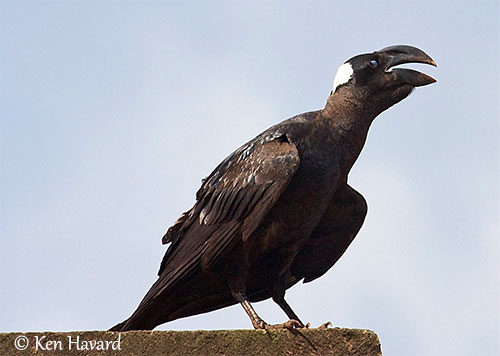
The Thick-billed Raven is usually observed alone or in pairs, but up to 12 individuals or more gather at rubbish dumps and slaughterhouses. They probably roam over long distances while searching for food.
The pair is suspected to remain on the territory all year round. They are monogamous with long-term pair-bond. They are solitary nesters.
During courtship, mutual preening is usual, often directed at head and neck that the birds cannot reach themselves. This behaviour maintains the pair-bond between mates, but also between the members of a group.
This large raven nests in a large platform made with sticks and branches, placed in fork in a large tree.
The Thick-billed Raven is mainly sedentary, but it wanders in E Sudan, NW Somalia and S Ethiopia.
It soars and glides on thermals over cliffs and mountainous areas, often with Raptors. It performs tumbling aerobatics and both mates may sometimes lock their feet together before twisting down into ravines before breaking apart.
During the take-off, the wings produce a loud, swishing sound, but once airborne, the bird performs slow, shallow wingbeats.
REPRODUCTION OF THIS SPECIES:
The laying takes place between December and April, but mainly January, in Ethiopia. Two broods are occasionally laid.
The Thick-billed Raven is solitary nester. The large nest is placed 15-20 metres above the ground, in a fork formed by large branches in a large tree. It may occasionally nest (but rarely) on cliff ledge.
The nest is a platform made with branches and sticks firmly fixed in the fork. The cup is lined with soft material such as animal hair and wool, grass, string…
The female lays 4 turquoise eggs with pale and reddish-brown markings. In the family Corvidae, the incubation is usually performed by the female alone. The young remain within the family group for several months after fledging.
PROTECTION / THREATS / STATUS:
The Thick-billed Raven is described as “relatively common” over its restricted range. It is even locally abundant and widespread in the highlands of Ethiopia and Eritrea.
Very opportunistic like most Corvidae species, it occurs in a variety of habitats where it is not globally threatened.
The population is suspected to be stable and the Thick-billed Raven is currently evaluated as Least Concern.
Fr: Corbeau corbivau
Ang: Thick-billed Raven
All: Erzrabe
Esp: Cuervo Picogordo
Ita: Corvo imperiale beccogrosso
Nd: Dikbekraaf
Sd: tjocknäbbad korp
Photographers:
Ken Havard
My Bird Gallery & Flickr gallery 1 & Flickr gallery 2
Ingo Waschkies
Bird Photography
Callie de Wet
GALLERY
Text by Nicole Bouglouan
Sources:
HANDBOOK OF THE BIRDS OF THE WORLD Vol 14 by Josep del Hoyo-Andrew Elliot-David Christie - Lynx Edicions – ISBN: 9788496553507
BIRDS OF AFRICA SOUTH OF THE SAHARA by Ian Sinclair and Peter Ryan - Princeton University Press Princeton and Oxford - ISBN: 0691118159
CROWS AND JAYS by Steve Madge – Ed. Christopher Helm – ISBN: 0713652071
CORBEAUX ET GEAIS: Guide des Corbeaux, Geais et Pies du Monde – Steve Madge, Hilary Burn – Editeur : Vigot (18/04/1996) – ISBN 10: 2711412687 – ISBN 13 : 978-2711412686
THE AVIANWEB - Beauty of Birds (Sibylle Faye)
Wikipedia, the free encyclopaedia
Thick-billed Raven
Corvus crassirostris
Passeriformes Order – Corvidae Family
INTRODUCTION:
The Thick-billed Raven is the largest member of the family Corvidae. It is found in Eritrea, Somalia and Ethiopia where it lives in open or forested mountainous areas, between 1,500 and 3,400 metres of elevation.
The genus Corvus has an almost worldwide range except in South America. The members of this genus are large to very large with usually similar body shapes. They have strong, stout legs with strong feet and claws. Their large head often sports a distinctive bill. The Thick-billed Raven shows large, massive bill that may appear almost Hornbill-like in flight.
Like most ravens and other species of this family, it is carnivorous, but its diet also includes some plant material. However, this species is a true scavenger! They are solitary nesters and both mates are monogamous with long-term pair-bonds.
The Thick-billed Raven is usually described as relatively common throughout the range, and the population is stable and not globally threatened.
DESCRIPTION OF THE BIRD:
Biometrics:
Length: 60-64 cm
Weight of one bird: 1135 g
The Thick-billed Raven is very similar to the White-necked Raven (C. albicollis), and both species are sometimes placed in a separate genus “Corvultur”.
The long tail is wedge-shaped. The wings are broad and the long primaries are strongly fingered. The plumage is black. The upperparts show blue to purple-blue gloss, but wings and tail usually shows most glossy plumage. The underparts are duller. Throat, neck sides and breast are browner and less glossy.
On the head, the feathers are short and dense. The nasal bristles are shorter than in C. albicollis. They are upcurving but not reaching the culmen ridge. There is a fairly large white patch on the upper nape, extending in white line down centre of the nape.
The large, black bill is very massive and the culmen is strongly arched. The tip is whitish. The eyes are dark brown. Strong legs and feet are black.


Male and female have similar plumage, but the male is slightly larger.
The juvenile is duller than adults with more brownish plumage. The bill shows less arched culmen and the white tip is absent.
RANGE:
The Thick-billed Raven is found in the highlands of Eritrea and Ethiopia of which it is endemic. It may exceptionally wander to extreme E Sudan and NW Somalia, and S to the border of extreme N Kenya.
HABITAT:
The Thick-billed Raven is found in mountains and high plateaux in both open and forested areas with escarpments and steep cliffs. But it also frequents cultivated areas, lakeshores, and even cities and towns with large trees.
This species is visible from 1,200 to 4,100 metres of elevation, but more often 1,500-3,000 metres.
CALLS AND SONGS: SOUNDS BY XENO-CANTO
The Thick-billed Raven gives loud, guttural, wheezy croak “phlurk-phlurk”. We can hear hoarse gurgling and choking sounds during the courtship displays. Other sounds include deep grunting “gwrrrrurrr” or “grrrrarrr” and a double cough “harr-harrr”.
The calls are well high-pitched for such big Corvid, but the most usual calls of these species are loud for easier transmission in the environment.
BEHAVIOUR IN THE WILD:
The Thick-billed Raven is mainly carnivorous, but some plant materials are also taken. The diet includes large insects (locusts) and beetle larvae (Coleopteran), caterpillars and reptiles (lizards and snakes). On upland plateaux, it often digs with its massive bill for mole-rats and other rodents. It also robs bird nests from which it takes both eggs and chicks.
Like most Corvids, it is a true scavenger, especially near human habitations. It joins vultures around carcasses where the massive bill is suspected to impress these large raptors. It walks with the bill held towards them and the vultures give it way at the carcass. It also steals bones dropped by the Bearded Vulture, and joins Hamerkop and Marabou Stork on lake shores where they feed on dead fish. It also digs planted grain from fields, but only causing minor damages to the crops.
The Thick-billed Raven feeds mainly on the ground. It walks with bold, arrogant gait and in upright position, and hops easily. The head is held upright to enhance the large bill. But it also forages in tree canopy for insects and berries found in the foliage.
